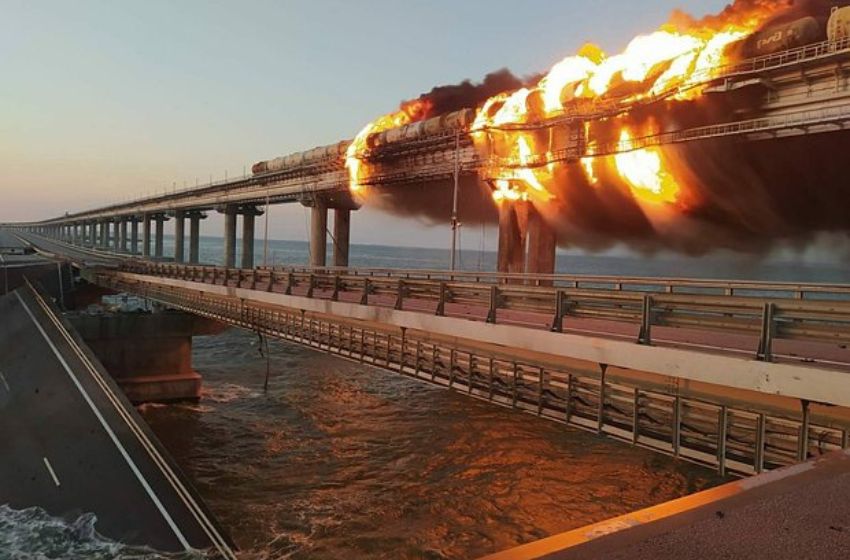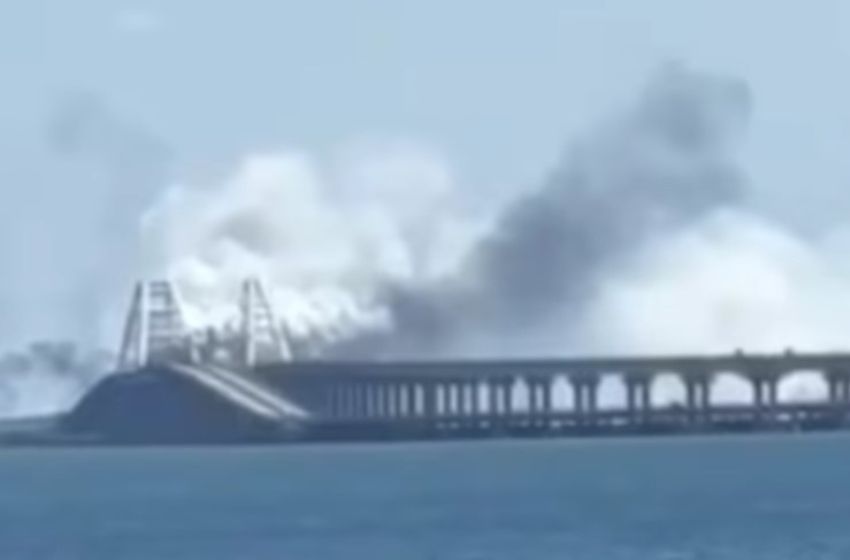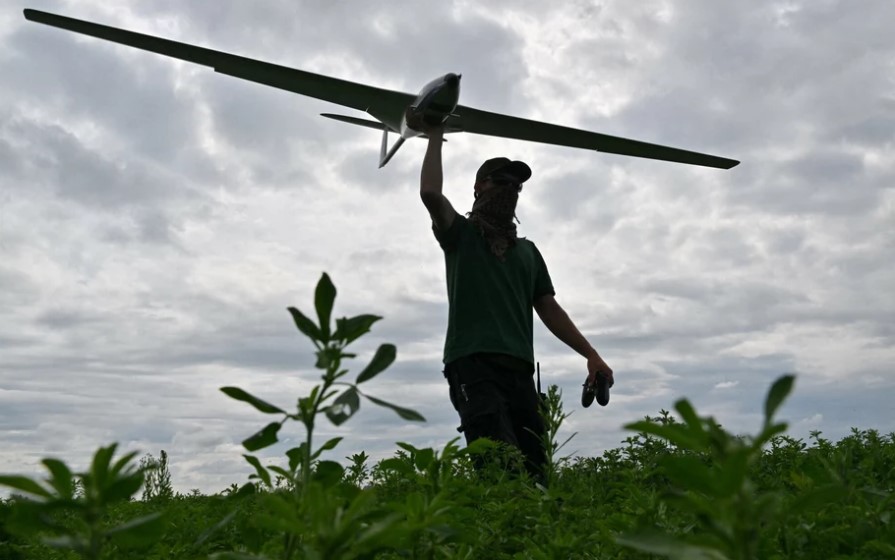Source: NV
The operation for the second detonation of the Crimean Bridge, initiated by the personnel of the Security Service of Ukraine, was symbolically named "Sea Baby." It's worth noting that this name is also given to the new generation of naval drones used by the SSU.
Eight months prior to this special operation, the Sea Baby team initially targeted the bridge, which is a crucial segment for Russian military supplies to Crimea and the occupied southern regions of Ukraine.
The first strike took place on a gloomy morning on October 8, 2022. At that moment, a significant flow of vehicles was crossing the bridge. At around 5:40, a loaded truck was recorded by a Russian video surveillance system camera, moving at high speed towards Crimea. In an instant, the long explosive device went off, damaging two spans and igniting a railway train with fuel-filled tanks that was moving parallel to the bridge. According to the Russian side, the blast resulted in the death of five individuals, including the truck driver, and completely halted bridge traffic.
Not only the occupants were monitoring this explosion, but there was also another camera whose real-time video was being watched by Vasyl Maliuk in his office in Kyiv. The exact location of this camera is undisclosed by the head of the SSU, but he assures that he closely observed the explosion in all its details.
The first operation on the Crimean Bridge angered the Russian dictator Vladimir Putin, for whom this crossing became a symbol of his success. Following the detonation that occurred just after the 70th anniversary of the Kremlin leader, the Russians launched a powerful missile attack on Kyiv and systematically shelled Ukraine's energy infrastructure. Additionally, in Russia, a special commission was formed to investigate the explosion's circumstances, comprising representatives from the Ministry of Emergency Situations, Ministry of Transport, Federal Security Service, Ministry of Internal Affairs (MIA), and the National Guard of Russia. Later, a Russian court sent eight suspects to pretrial detention, but as of now, the guilt of none of them has been proven.
The second strike on the bridge left a profound impression on the Kremlin, reinforcing Moscow's understanding that Ukraine is capable of demolishing this unlawfully constructed massive structure. Despite the Russian side repeatedly declaring the bridge's invulnerability to any form of weaponry and creating a special security system around it.
"The Kerch Bridge became an imaginary grail for the Kremlin. Therefore, its destruction not only disrupted logistics but also demonstrated that the Putin regime is just as fragile and unstable as the bridge's constructions," believes Alexander Kovalenko, a military-political expert. "This special operation had both military and political objectives, and all of them were incredibly successful."
First explosion
"I personally and two of my trusted colleagues were responsible for the planning and execution of the bridge operation," explains Vasyl Maliuk.
According to him, the Security Service of Ukraine had been contemplating the idea of undermining the Crimean Bridge since the spring of 2022. They considered various options, including transporting explosives in freight cars. However, the Russians prohibited the transportation of any cargo across the railway part of the bridge except for military supplies. Eventually, they settled on the option of using a truck loaded with barrels containing oil, within which the explosive device would be concealed.
But doubts about its effectiveness persisted. "It was crucial for the camouflaged explosive device to travel from point A to point B, crossing the Kerch Bridge in the process," explains Maliuk. The barrel method of concealment did not guarantee that.
Then, the head of the SSU came up with the idea of wrapping the explosive device carefully with plastic film. This cargo, resembling large rolls, appeared completely civilian and wouldn't raise suspicions.
The SSU calculated the thickness of the plastic layer, enough to hide metal cylinders filled with a mixture of hexogen from customs scanners.
They filled an entire container with these "rolls" - the total weight of them in TNT equivalent corresponded to 21 tons, or 42 Russian "hypersonic" Kinzhal missiles.
The passage of the cargo from Ukraine to the location of the explosion on the bridge was extremely challenging. However, Vasil Maliuk doesn't disclose the details of this risky route, citing the need to maintain strict confidentiality.
Just six days after the attack, five Russian citizens suspected of involvement ended up in detention centers. Later, their number grew.
Russian opposition journalist Elena Romanova, who resides in Germany and works for the "Novaya Gazeta. Europe," wrote about one of them - "Oleg Antipov, a logistician from St. Petersburg. Through him, one of the transportation deals for carrying the "polyethylene film" was arranged.
Antipov himself voluntarily went to the FSB after the bridge explosion and shared what he knew. He was initially released but then detained and sent to an isolation facility. Antipov remains in custody, serving as a living example of a widespread practice among Russian security agencies - in complex cases, they opt for the easiest "investigation" approach. "Russian security forces need to demonstrate their effectiveness. Therefore, they grab the first possible suspect and hang all the world's sins on them," says Romanova.

Second explosion
After the initial attempt, the SSU immediately began working on developing a new strike against the bridge.
The leader of one of the military counterintelligence units, call sign "Hunter," played a significant role in realizing this idea. This officer was involved in the creation of maritime drones.
Ukrainian intelligence operatives designed remotely controlled explosive-laden maritime kamikaze drones using a unique material that evaded enemy radar detection. These drones had a construction with three types of control mechanisms and self-destruct capabilities if necessary.
For the first time in the context of actual combat, engineers and specialists from the SSU tested the floating drones on ships of the Russian Black Sea Fleet when they attacked the missile frigates Admiral Makarov and Admiral Essen in Sevastopol Bay last autumn. Following this special operation, the latter ship remained in dock for repairs for a long time.
Realizing that the drones were not capable of sinking large vessels, the amount of explosives on them was increased to 850 kg of hexogen. The control system of the drones was also upgraded, resulting in a qualitatively new model of surface "avenger."
Maluyk brought Commander of the Ukrainian Navy Oleksiy Neizhpapa into collaboration, who provided significant assistance in the implementation of the entire project. The joint team of the fleet and intelligence services began preparing a maritime operation to sabotage the Crimean Bridge.
In mid-July, the SSU and the Ukrainian Navy finally launched the drones into the open sea, directing them towards the target. "For two nights, we didn't sleep — we were literally monitoring the drones every minute. We were so full of excitement that we had to calm the guys down a bit, so they wouldn't rush the drones," recalls Maluyk.
Finally, the drones struck the support structure of the bridge, causing, based on photos later released, significant damage to its automotive section.
"When the explosion happened, we shouted very loudly because the tension inside was immense," admits Maluyk. "I'll be honest: I was praying for everything to go well. And when the drone exploded, we 'exploded' with joy too."

The head of the SSU, describing the details of the attacks on the Crimean Bridge to NV, emphasized several times that these operations were prepared exclusively by Ukraine's efforts and no foreign intelligence agencies were involved.
Similarly, Maluyk clarified that the Crimean Bridge is a legitimate target for Ukraine. For example, the Geneva Conventions, which regulate certain rules of warfare, do not contain a prohibition on attacking such objects. The Law of War Handbook, which is the Instruction for US Army Operations, defines "interfering with lines of communication, movement, or contact" as a legitimate target.
Valeriy Kondratiuk, former head of the Main Intelligence Directorate and former chief of the Foreign Intelligence Service, commenting on the actions of his colleagues from the SSU, assures that the bridge operations were conducted to inflict maximum damage on the Kremlin while maintaining good relations with Western partners.
"It's a very delicate job for the intelligence service - to be effective and successful in operations while balancing the fears of foreign nations of nuclear war," believes Kondratiuk. "This formula embodies the strenuous work and titanic dedication of Ukrainians."





















